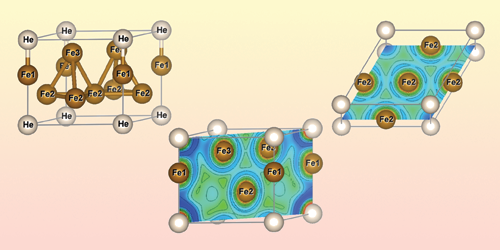Iron–Helium Compounds Form Under Pressure
Noble gases are famous for being inert. But there are ways to coax even these elements into forming compounds. Heavy members of the group, such as xenon, can be made to react by subjecting them to high pressure, and recent studies indicate that, under sufficiently high temperatures and pressures, helium reacts with molten iron. Haruki Takezawa at the University of Tokyo and his colleagues have now demonstrated a process by which helium can be made to form stable compounds with solid iron [1]. They say that their findings support the possibility that our planet’s solid inner core could host a reservoir of ancient helium.
The researchers crushed iron foil and helium gas at 5–54 gigapascals in a diamond-anvil cell. They used a laser to gradually heat the cell’s contents up to 2820 K and analyzed the resulting products using synchrotron x-ray diffraction measurements. These diffraction measurements revealed that, during the compression and heating process, the iron switched from its usual body-centered cubic structure to either a face-centered cubic (FCC) or a hexagonal close-packed (HCP) structure.
Both FCC and HCP were already known as two of iron’s high-temperature, high-pressure crystalline forms. But in the new experiments, the volumes of the unit cells were remarkably large: up to 48% greater than that of pure iron at an equivalent pressure. The researchers propose that the lattice expansion is due to helium atoms being incorporated into the structure, with the resulting compound containing an amount of helium corresponding to the volume increase. After fully depressurizing the cell, the lattices of both crystalline forms held their structures, allowing the researchers to measure the compounds’ helium concentrations using spectrometry. They then verified the results using first-principles calculations.
–Rachel Berkowitz
Rachel Berkowitz is a Corresponding Editor for Physics Magazine based in Vancouver, Canada.
References
- H. Takezawa et al., “Formation of iron-helium compounds under high pressure,” Phys. Rev. Lett. 134, 084101 (2025).




